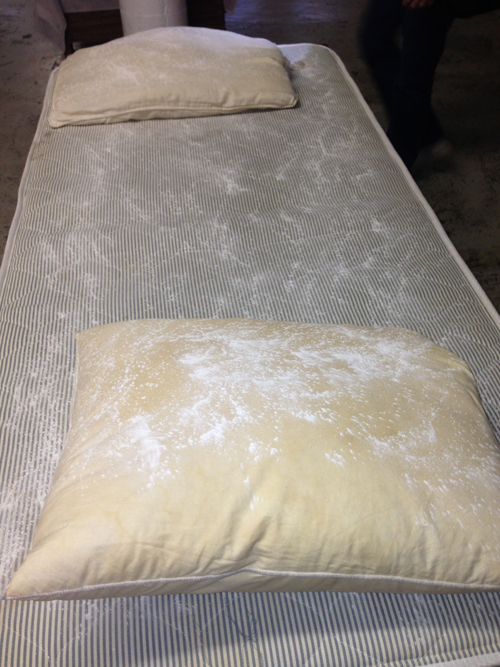
Improper application of an insecticide dust to a mattress and pillows by a non-professional. Dusts are designed for light application to crevices and voids, out of reach of people.
The quest for home remedies for bed bugs appears to be never-ending. However, in the latest revelations from researchers, it seems that very few home insecticides are worth the time or trouble when battling bed bugs. That’s not to say that some of these products won’t kill some bed bugs, but the ideal product for killing bed bugs just isn’t out there, experts say.
A recent article in Science News gloomily summarizes some of the most current information about DIY bed bug control, based on papers presented on bed bugs at last month’s annual conference of the Entomological Society of America in Austin, TX.
It turns out that rubbing alcohol, bug bombs and other products just don’t work that well. And some products, like ultrasonic repellers, are completely ineffective. Rubbing alcohol only killed about half of the bed bugs that were sprayed directly in one test, and bed bugs confined in a plastic bag for seven days with mothballs (a much higher exposure than you would expect in a clothes closet or storage chest) had about the same survival rate.
After attending another recent bed bug meeting, I noticed that the effectiveness of diatomaceous earth (d.e.) is being hotly debated as well. Over the years, pest management professionals have reported success with d.e. as part of a integrated approach to bed bug control. And DIYers have also embraced d.e. as a safe, effective and readily available bed bug treatment. However, d.e. is not really designed for broadcast use, and few non-professionals apply it correctly (see image). To liven the debate, one recent field study conducted by professionals found that it provided only marginal results when used by itself, without supporting sprays or other treatments. Such field studies are much more difficult to conduct, but provide a better estimate of how a product performs in real life compared to laboratory tests.
Why the conflicting results? No one knows for sure. But d.e. is an abrasive that scrapes away some of the protective waxes that keep bed bugs from desiccating in the dry indoor environments of homes. The effectiveness or ineffectiveness of d.e. may have something to do with the source or form of the diatomaceous earth (the various d.e. products are mined from different geological deposits and thus may vary in abrasiveness), or it may have to do with the environmental humidity or availability of food. Many insects can compensate for water leakage by taking in more water from feeding. Perhaps bed bugs in the field are able to compensate for moisture loss by taking in more moisture through blood feeding. Not a pleasant thought.
So what can the average person do when faced with a bed bug problem? Professional help, in my opinion, is still the best option for a bed bug infestation of any magnitude. But many folks, for a variety of reasons, don’t have access to good professional help. If that’s your case, it’s still possible to battle bed bugs. I’ve tried to lay out some DIY options in my fact sheet on this topic; but keep in mind that there is still no magic bullet for bed bug control.
Dogged persistence, thoroughness and a some knowledge about bed bugs is the best medicine for DIYers.